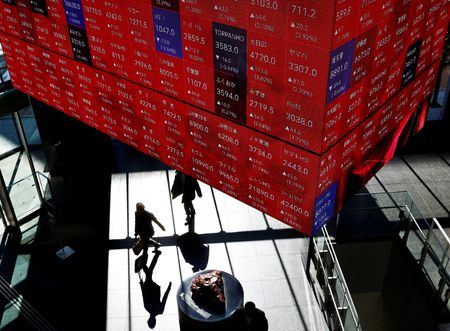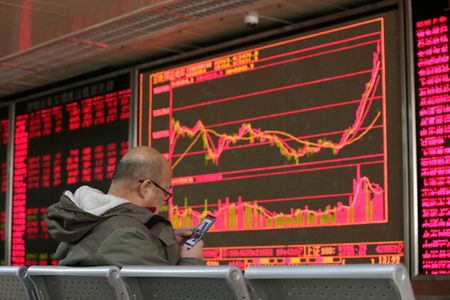By Rae Wee and Greta Rosen Fondahn
SINGAPORE/GDANSK (Reuters) -The yen rose after the Bank of Japan hiked rates on Friday and revised up its inflation forecasts, while the dollar touched a one-month low after U.S. President Donald Trump suggested a potentially softer stance on tariffs against China.
The BOJ raised rates by 25 basis points at the conclusion of its two-day policy meeting, in a move that had been well telegraphed by policymakers prior to the outcome.
The yen rose to 154.845 per dollar following the policy decision, but pared some gains after Governor Kazuo Ueda’s press conference, where he said that a rise in underlying inflation was “moderate” and the central bank wasn’t “seriously behind the curve”, suggesting no rush to tighten policy again.
The yen was last up 0.55% at 155.19 per dollar.
“There’s more than just the Japanese economy and wages that determine when the next BOJ rate hike can come, and the global uncertainties from Fed’s slowing rate cuts and the risk of tariffs in the new Trump administration remain out of Ueda’s control,” said Charu Chanana, chief investment strategist at Saxo.
Earlier on Friday, data showed Japan’s core consumer prices rose 3.0% in December from a year earlier to mark the fastest annual pace in 16 months.
The yen was also supported by comments from Trump, who suggested a potentially softer stance on tariffs against China while separately saying he wants the Federal Reserve to cut interest rates, which sent the dollar lower across the board.
In an interview with Fox News that aired on Thursday evening, Trump said he would rather not have to use tariffs over China and that he thought he could reach a trade deal with the world’s second-largest economy.
“This seems to feed into the growing sense that Trump is underdelivering on protectionism compared to pre-inauguration remarks, and that ultimately some of those tariff threats may not materialise as long as some concessions are made on trade,” said Francesco Pesole, currency strategist at ING.
The Australian and New Zealand dollars were riding high from Trump’s remarks. The Aussie jumped 0.6% to reach a five-week top of $0.633, while the kiwi similarly scaled a five-week peak of $0.5719.
The two Antipodean currencies are often used as liquid proxies for the Chinese yuan.
The Chinese yuan similarly got a lift on the back of Trump’s remarks, with the onshore unit rising to its strongest level in eight weeks at 7.2370 per dollar.
TRUMP COMMENTS HIT DOLLAR
Trump’s latest comments on China tariffs and inflation kept the dollar on track for its worst weekly fall in over a year.
Investors have sold the dollar in the wake of Trump’s inauguration after his widely expected tariff announcements did not immediately materialise, unlike what he had threatened during his campaign.
The greenback extended losses to hit a one-month trough of 107.46 against a basket of currencies, and was set to lose more than 1.7% for the week.
The euro, meanwhile, rose 0.7% to $1.0488 and was headed for a roughly 2.1% weekly gain.
Sterling advanced 0.4% to $1.2402 and was similarly poised for a rise of 1.9% for the week, snapping three straight weeks of losses.
Trump’s remarks come just days before the Fed’s first policy meeting to be held during his administration, with very broad expectations officials will leave rates unchanged.
In cryptocurrencies, bitcoin was last 2.27% higher at $105,499.
Trump on Thursday ordered the creation of a cryptocurrency working group tasked with proposing new digital asset regulations and exploring the creation of a national cryptocurrency stockpile, making good on his promise to quickly overhaul U.S. crypto policy.
(Reporting by Rae Wee in Singapore and Greta Rosen Fondahn in Gdansk; Additional reporting by Brigid Riley; Editing by Jacqueline Wong, Shri Navaratnam, Kim Coghill and Emelia Sithole-Matarise)











